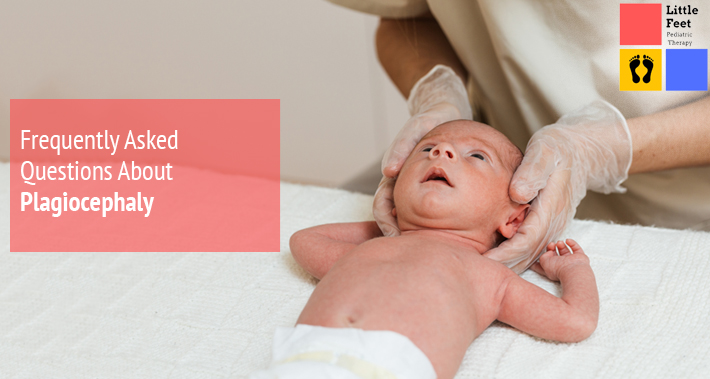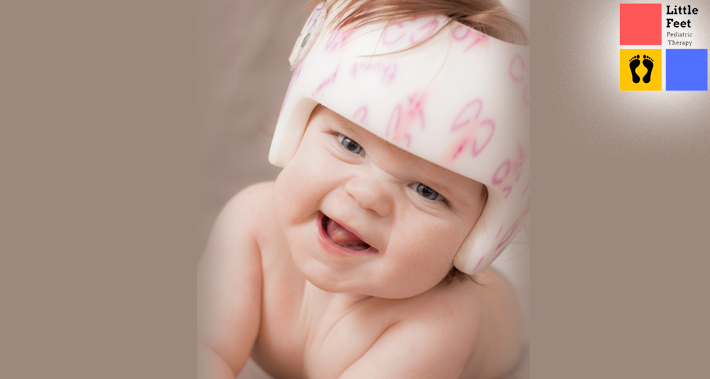
Have you ever noticed a flattened area on the front, side, or back of your baby’s head?
Is your baby’s nose pushed to one side?
If so, these are the potential signs of plagiocephaly.
Plagiocephaly is an umbrella term used to reference the many types of skull deformations.
If your child has plagiocephaly, a pediatric physical therapist at one of our Little Feet Therapy clinics can help.
We’re a therapy clinic for kids with a wide variety of areas of clinical focus, including treatments for plagiocephaly.
Thankfully, plagiocephaly is typically mild, and can be easy to treat.
However, we find that parents often have a lot of questions about plagiocephaly.
That’s why this week on our pediatric therapy blog, we’ll be looking at some of the most frequently asked questions about plagiocephaly.
Are There Different Types Of Plagiocephaly?
Plagiocephaly belongs to an umbrella category of conditions called infant flat head syndrome.
These are conditions related to the shape of your baby’s head, and include:
- Plagiocephaly
- Brachycephaly
- Dolichocephaly
- Craniosynostosis
Let’s take a look at each one.
Plagiocephaly
Plagiocephaly is the most common form of infant flat head syndrome.
In this condition, usually one side of the back of your infant’s head has a flat spot, making their head asymmetrical.
This may occur due to your baby spending too much time on their back or they may be born this way due to womb positioning.
Brachycephaly
With brachycephaly (also known as short head), the back of your baby’s head may appear shorter or wider.
This is a result of an abnormal skull length to width ratio.
Dolichocephaly
With dolichocephaly, your baby’s head will appear elongated, flattened on the sides.
This commonly happens when babies have breech or frank breech positioning in the womb.
Craniosynostosis
Lastly, a rare type is craniosynostosis, also called congenital plagiocephaly.
A newborn baby’s skull is normally made up of several separate parts.
There are spaces between them, which allows your baby’s skull to grow.
Typically, they fuse together around the age of 2.
In craniosynostosis, however, your baby’s skull fuses earlier than they should.
Your baby’s head may stop growing where the sutures fused too early or continue growing where the sutures haven’t fused.
This results in a head that is asymmetrical.
If multiple sutures are fused too early, your baby may experience pressure in the skull.
This condition often requires surgery to correct.
Do All Babies With Plagiocephaly Also Have Torticollis?
When babies are first born, their skulls are more malleable, and harden as they grow.
When they spend a lot of time lying in the same position, it can cause plagiocephaly.
Torticollis, on the other hand, is a condition where your baby’s head is titled to one side, restricting movement.
It’s not uncommon for torticollis to cause plagiocephaly, but not all babies will have both.
It can also work the other way around as well.
Torticollis can cause plagiocephaly, and plagiocephaly can cause torticollis.
If your baby with plagiocephaly favors one side of the head, their sternocleidomastoid (SCM) muscle may shorten or tighten, which limits their head motion.
This can cause their head to turn to one side, which could cause torticollis.
RELATED: Frequently Asked Questions About Torticollis
Does Plagiocephaly Cause Pain Or Discomfort?
No, plagiocephaly is not painful for your baby.
This condition can be challenging for those around the baby though, including you as a primary caregiver.
However, early detection and intervention of plagiocephaly is important, since treatment becomes much more complex once your baby’s skull hardens.
These early forms of treatment are also not painful.
Does Plagiocephaly Affect Brain Development?
The symptoms of mild plagiocephaly are generally cosmetic in nature, and won’t affect cognitive development.
It’s important to note, though, that cosmetic symptoms can still lead to poor self esteem and difficulty developing social skills.
More serious cases of plagiocephaly are relatively rare.
If left untreated, though, plagiocephaly can sometimes cause cognitive issues.
As a result, it’s always a good idea to get treatment for your child’s plagiocephaly.
Is Plagiocephaly Life Threatening?
No, plagiocephaly is not life threatening.
However, it’s still a good idea to seek a therapeutic evaluation for your child if you suspect they may have plagiocephaly.
How To Tell If My Baby Has Plagiocephaly
The symptoms of plagiocephaly may vary based on its severity.
There are some common signs in plagiocephaly to look out for, though.
You may notice one or more of these signs if your baby has plagiocephaly:
- A head that’s flatter on one side at the back, side, or front
- Less hair on the side of the head that is flat
- Their ear is pushed forward on the side that is flattened
- A misshaped or slanted head
- Their nose is pushed to one side
- Their eyes may look unlevel
A baby with more severe symptoms may also:
- Have a forehead, eye or cheek that is fuller on one side
- Have an uneven forehead
If torticollis is the cause, you may also notice that their neck, jaw, or face are asymmetrical.
How Common is Plagiocephaly?
Plagiocephaly is a very common condition that occurs in babies.
In fact, plagiocephaly occurs in up to 50% of babies.
These cases are usually mild in nature.
What Happens If Plagiocephaly Is Untreated?
Plagiocephaly may go away by itself and usually improve by the age of one or two.
In some cases, however, it may require treatment.
If your baby does not receive treatment, their plagiocephaly symptoms may worsen.
One consequence of waiting is that if the skull is fully formed and sealed, it is likely too late to correct the flattened appearance of your baby’s head without more invasive options.
Adults in studies report short and long term psychological and physical impacts of untreated plagiocephaly.
Some cosmetic issues may arise like jaw alignment issues, misaligned ears, and shorter hair than usual.
These asymmetrical features may result in bullying, which can impact your child’s mental health and confidence levels.
This can also impact one’s ability to socialize with others and increase your child’s risk for depressive disorders.
They may also be unable to wear protective headwear or glasses due to their misaligned ears and the shape of their head.
More severe cases of plagiocephaly may cause:
- Feeding issues
- A limited field of vision
- Issues with balance and coordination
- Delays in speech and language development
- Delays in gross motor skills development
- Delays in fine motor skills development
- Delays in thinking and learning skills development
- ADHD
RELATED: Pediatric Therapy for Developmental Delays

What Is Cranial Band Therapy?
Cranial band therapy is also called helmet therapy.
It’s a common form of treatment for plagiocephaly.
In this form of therapy, your baby will wear a special helmet to correct the shape of their skull over time.
This helmet changes the shape of your baby’s skull.
It captures natural growth, inhibits growth in prominent areas, and allows for growth in flat regions.
Adjustments occur until your baby’s head grows into a typical and more symmetrical shape.
How Long Does Cranial Band Treatment Take?
The length of treatment will depend on the needs of your baby.
It differs based on the severity of their symptoms, their age, and the presenting issues.
This will all depend on how your child’s skull is reshaping over time.
Usually, if the case is treated soon after diagnosis or the child is younger, the correction is faster.
The typical length of time for a cranial band to be worn is 2-6 months depending on the child’s age and severity.
A general rule of thumb is that the younger the child, the shorter the time they will need a cranial band due to the skull being more malleable.
Is Using A Cranial Band Uncomfortable For My Baby?
No, it’s not uncomfortable.
The helmet acts as a mold for your baby’s head to develop into a more typical shape and doesn’t cause pain.
Mild issues like odors, skin irritation, and sweating can be rectified by removing the helmet for short periods of time to bathe.
Will Plagiocephaly Resolve On Its Own?
This usually depends on the severity of the condition.
In mild cases, it may sometimes resolve on its own.
In moderate and severe cases, however, your baby will need treatment.
What To Do If My Baby Has Plagiocephaly?
If you suspect your baby may have plagiocephaly, it’s a good idea to book an assessment with a pediatric physical therapist.
If physical therapy begins before your baby is 3 months old, their head is typically reshaped without a cranial band.
Here at Little Feet Pediatric Therapy, we’ll pair you with one of our therapy team members who has experience with plagiocephaly.
They’ll conduct an evaluation and advise on a treatment plan to fit your baby’s needs.
This may include helmet therapy, as well as strategies you can use at home to help.
Book Your Appointment With Little Feet Pediatric Therapy Today
If your baby has plagiocephaly, or you suspect they do, it’s always a good idea to seek treatment.
A pediatric physical therapist is a great place to start.
Book your appointment with Little Feet Pediatric Therapy today.
► 3535 Randolph Rd, Charlotte, NC 28211
► 1331 H St NW Ste 200, Washington, DC 20005
► St. Louis, MO
► Raleigh, NC
Founded in 2019, Little Feet Therapy offers on site pediatric physical and occupational therapy treatments for children from 2 months to 18 years old with physical and developmental concerns. Our clinics focus on providing therapy in a child’s natural setting where your child is in familiar surroundings, it puts their mind at ease and helps them focus more on the work they’re doing with their pediatric therapist. Our therapists will work with your child at your home, at school, at daycare, or another place in the community where they feel most comfortable.